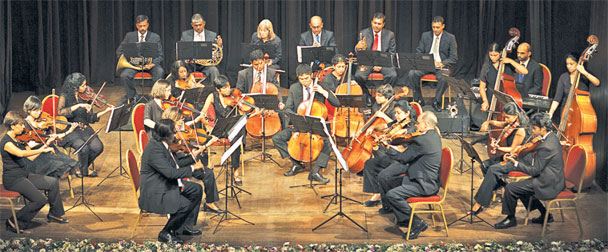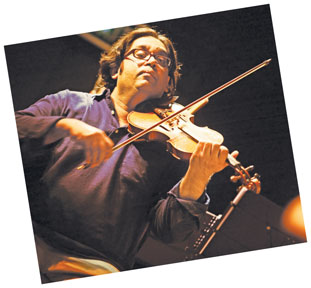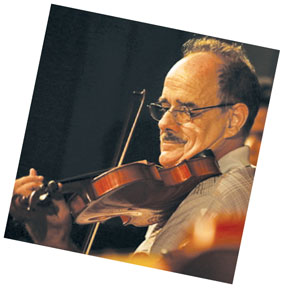|
Review
Fire and flamboyance with passion!
By Ranga CHANDRARATHNE
On March 22, at 7.30 p.m. the 2012 season premiere concert of the
Chamber Music Society of Colombo saw the Society return to its most
comfortable habitat, the music of the late baroque and early classical
eras. A full, engrossed and highly disciplined (no clapping between
movements and phones going off) Lionel Wendt Theatre witnessed some
incandescent playing by the orchestra, by far the most progressive and
satisfying there is in Sri Lanka today.
 If we at 'Montage' have on previous occasions, come across as
excessively concerned and critical of musical and extra musical details
by the CMSC, it is only because they are a well-funded professionally
led organisation, top to bottom, and thereby open to serious critical
scrutiny requiring much higher standards and accountability than other
well-meaning but amateur/hobbyist led groups of similar ilk, it is only
fare. But this concert, it would be disingenuous to find much to
complain about. If we at 'Montage' have on previous occasions, come across as
excessively concerned and critical of musical and extra musical details
by the CMSC, it is only because they are a well-funded professionally
led organisation, top to bottom, and thereby open to serious critical
scrutiny requiring much higher standards and accountability than other
well-meaning but amateur/hobbyist led groups of similar ilk, it is only
fare. But this concert, it would be disingenuous to find much to
complain about.
Classical genius
The concert opened with W.A. Mozart's overture to the opera, 'Apollo
et Hyacinthus' or the 'Metamorphosis of Hyacinth.' A short but intense
utterance by the undisputed classical genius. And true to form, the
tightly knit orchestra of the CMSC driven hard by its fiery artistic
director and concertmaster, Lakshman Joseph de Saram, roared out of the
start gate amounting to some truly exhilarating playing. The elite 26
musicians sounded much more powerful and alive than is usually the norm
in Sri Lanka.
The Latin school-opera that Mozart wrote when he was just over 11
belongs to a tradition that is unaccustomed to us because most of its
products are trivial and anyway few of them have survived. 'Apollo et
Hyacinthus' was designed for performance in the intervals of a five-act
tragedy and features one aria for each character, and three ensembles.
It is also possibly the least recorded of the master's operas.
The relentless pace set by the overture continued with more
high-spirited Mozart, his unusual symphony number 23 in D major K 181.
What is distinct about this work is that he wrote it as a single
continuous movement comprising of three distinct tempi: Allegro
spiritoso, Andantino grazioso and Presto assai. Here too, the playing
was first rate, the excitement and naiveté of the teenage Mozart brought
to the fore. The first movement was full of energy and spirit with
well-judged swells of sound and disciplined ensemble work. The 2nd
movement titled Andantino grazioso had a beautiful extended solo for
oboe, played by the Society's principal oboist, Hasitha Pathirana.
His cautious but appropriate rendition was the first real point of
relaxation in the program. The orchestra accompanied him with a thickly
veiled sound bed of murmuring strings. The 3rd movement was up and
running before you could even imagine pausing for reflection. Mostly
precise playing and superbly graded balances between strings, woodwinds
and brass.
Georg Fredrick Handel's Concerto Grosso in G major, HWV 319 (op. 6
no. 1) was next. The formidable string section of the Society taking
center stage, they chose a thoughtful interpretation avoiding extremes
of tempo yet not running into monotony. Their modern instruments sounded
more than agreeable and the harpsichord was mostly appropriate and
unobtrusive. A slight mishap in the sequence of movements that
culminated in an unprecedented false start by the esteemed
concertmaster, led to a slightly humorous but generous admission of
responsibility by the 'first chair,' much to the delight and admiration
of the audience. The switching of last movements that led to the glitch
was unfortunately not explained, a pity.
 |
|
Lakshman J. de Saram |
 |
|
Othman H. Majid |
The G major Concerto is one of a series of twelve elegant concerti
grossi in which Handel explores complex fluctuating relationships among
the instruments of a string orchestra. In agreement with the traditions
of concerto grosso style he exploits the difference between a small
concertino (group of solo instruments) and a larger ripieno (orchestral
accompaniment). Throughout this cycle the concertino features two
violins, a cello, and a chordal continuo instrument, and the ripieno
comprises larger groups of violins and violas along with a continuo
usually played by cellos, basses, and one or several chordal
instruments. After the intermission, the string section returned to
dazzle with Arcangelo Corelli's Concerto Grosso in D major, op. 6 no. 4.
A truly inspirational performance that made you want to explore more of
the works of the Italian baroque master, a higher compliment cannot be
made. Ensemble was top notch with just the occasional intonation fluff.
The slow movement was especially poignant in its simplicity, the faint
tinkling of the harpsichord adding to the flavor. The finale was all
about the flamboyance of the violin soloists, the Chamber Music
Society's exclusives, Lakshman Joseph de Saram and Othman H. Majid. The
sheer exuberance was breathtaking; the extreme speed of the coda left
you panting, literally. Although Corelli was not the inventor of the
Concerto Grosso, it was he who established the potentialities of the
form, made it widespread, and wrote the first great music for it.
Through his efforts, it achieved the same pre-eminent place in the
baroque period of musical history that the symphony did in the classical
period. Without Corelli's successful models, it would have been
unworkable for Vivaldi, Handel, and Bach to have given us their Concerto
Grosso masterworks.
No rival
Ending the season premiere concert was Franz Joseph Haydn's Symphony
no. 44 in E minor, Hob. 1:44 "Trauer." Proving once more, that the CMSC
has no rival in classical programming in the country, they naturally,
saved the best for the last. Outstanding performance of sheer adrenaline
in the first and last movements, with the severe minuet and trio, a
study in counterpoint and the sweetly melancholic slow movement bringing
some badly needed respite in-between.
It must be remarked that the amazing energy and spirit generated by
the musicians on stage that night was an astonishing experience, a
master class on inspired leadership and quality over quantity by
professionals with unconditional passion towards their art. It was a
pity that we did not notice too many players and managers of 'school
orchestras' in the audience; they could have learned something,
possibly. The concert attracting a packed elite audience that had at
least four ambassadors and your culturally inclined tycoons,
philanthropists and music lovers, was sponsored by Sri Lanka's most
recognized global brand, Dilmah Tea.Bravo! To all involved that night
for the magic, and for making us experience, in however a small way, the
remarkable sensation of our peoples collective artistic distinction. We
all left the hall that much richer.
|

